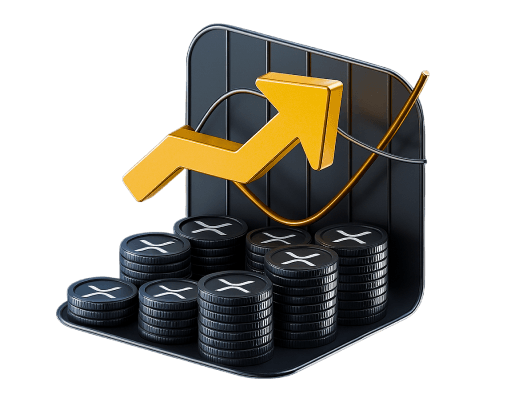
Understanding XRP's Core Blueprint
To analyze any investment, one must first understand the asset's fundamental purpose. XRP is distinct from other major cryptocurrencies; it is not a decentralized store of value like Bitcoin, nor is it a world computer like Ethereum. Instead, its mission is highly focused: to be an efficient digital asset built for payments. It operates on the XRP Ledger (XRPL), a decentralized, public blockchain engineered for speed and low transaction costs.
Unlike Bitcoin or Ethereum, which use energy-intensive mining to validate transactions, the XRPL employs a unique consensus mechanism that confirms transactions in 3-5 seconds for a fraction of a cent. All 100 billion XRP tokens were created at its inception, meaning it is 'pre-mined'. This design eliminates mining and its associated inflation but has drawn criticism, particularly regarding the large portion held by its affiliated company, Ripple Labs. XRP's primary function is to serve as a 'bridge currency'—a neutral asset that facilitates rapid and inexpensive cross-border payments between different fiat currencies, bypassing the slow and costly traditional correspondent banking system.
The Utility Thesis: Translating Promise to Profit
The core investment case for XRP rests on its utility. For years, it has ranked among the top cryptocurrencies by market capitalization, ensuring deep liquidity and widespread availability on global exchanges. Proponents argue that its technology is not theoretical but battle-tested. The proposition is straightforward: if the global financial system requires a faster, cheaper way to move money, and XRP is the best tool for the job, its value should appreciate as adoption grows.
This utility is central to Ripple's payment solutions, which use XRP to provide on-demand liquidity for financial institutions. The scalability of the XRPL, capable of handling 1,500 transactions per second, further strengthens this case. Therefore, the investment thesis is a long-term bet that real-world, enterprise-level adoption will become the primary driver of its value, moving it beyond the speculation that fuels much of the crypto market.
A Digital Arms Race: XRP's Position Among Rivals
In the crowded digital asset market, context is critical. Compared to Bitcoin, XRP offers superior speed and energy efficiency but lacks Bitcoin's established narrative as a store of value and an inflation hedge. Against Ethereum, XRP is less a platform for decentralized applications and more a specialized tool for payments. Its focused nature is both its primary strength and its limitation.
However, the most direct threat comes from competitors with similar goals. Stellar (XLM), co-founded by a former Ripple executive, targets the same cross-border payment niche, though with a greater focus on individual users and developing nations. Furthermore, the rise of central bank digital currencies (CBDCs) and other payment-focused blockchains means XRP is not alone. An investor must assess whether XRP's established partnerships and technological maturity provide a sufficient competitive advantage to defend against these rivals.
Decoding the Charts: Timing an Entry into a Turbulent Market
Analyzing XRP's price history presents a unique challenge. While macro market cycles, such as Bitcoin-led bull and bear markets, influence its trajectory, XRP's price is notoriously sensitive to legal news. Developments in the Ripple vs. SEC case in the United States have historically acted as powerful and immediate price catalysts, often overriding broader market sentiment.
This makes technical analysis difficult and timing an entry point fraught with risk. The common strategy of 'buying the dip' must be applied with extreme caution. A price drop may not be a cyclical market-driven opportunity but a reaction to a negative legal ruling that fundamentally alters the asset's risk profile. For potential investors, staying informed about regulatory news from the US is a fundamental component of market analysis for XRP.
The Ripple Effect: Corporate Partnerships and Institutional Adoption
A key element of XRP's investment case is its connection to the corporate world through Ripple Labs. While many crypto projects focus on theoretical use cases, Ripple has actively forged partnerships with hundreds of financial institutions globally. These collaborations, centered on using Ripple's technology for international payments, provide a layer of credibility and potential demand that is rare in the crypto space.
These partnerships signal that established financial players see value in the technology underpinning XRP. Although not every partnership directly translates into open-market trading of XRP tokens, they build a powerful network effect. This institutional foothold suggests a long-term strategy focused on integrating with the financial system, a stark contrast to the more disruptive ethos of other cryptocurrencies. For an investor, this represents a tangible foundation of enterprise-level interest.
The Shadow of Regulation: Confronting XRP's Future Risks
No analysis of XRP is complete without addressing its most significant risk: the legal battle with the U.S. Securities and Exchange Commission (SEC). The lawsuit, filed in December 2020, alleges that Ripple conducted an unregistered securities offering by selling XRP. This has cast a long shadow over the asset, leading to its delisting from major US exchanges and creating profound uncertainty.
A definitive ruling that classifies XRP as a security in the US could severely hamper its utility and adoption within the world's largest economy. While a partial court ruling in 2023 offered some clarity, the legal saga is ongoing. This single issue represents a potential binary outcome for the investment. Beyond this legal case, XRP is also subject to broader crypto market risks, including high volatility and intense competition from other payment-focused blockchains and fintech solutions.
Building Your Strategy: A Prudent Approach to XRP
Given XRP's unique risk-reward profile, a single strategy does not fit all investors. A long-term holder is betting that XRP's utility and Ripple's institutional network will eventually overcome current legal uncertainties, which requires patience and a high tolerance for volatility. A short-term trader, conversely, may seek to capitalize on that volatility by trading on news related to the SEC case.
For most investors, a more prudent approach is essential. This involves rigorous personal research and defining one's risk tolerance before committing capital. Crucially, any investment in XRP should be part of a well-diversified portfolio. Allocating a small, speculative portion of capital that one can afford to lose is a sensible way to gain exposure to its potential upside without jeopardizing broader financial stability.
Mapping the Trajectory: Key Signposts for 2025 and Beyond
Looking ahead, several key factors will define XRP's path. The most critical is achieving regulatory clarity. A final, favorable resolution to the SEC case would be a monumental catalyst, while a negative outcome would be a major setback. Outside the US, Ripple's success in securing licenses and approvals in key financial hubs like Singapore, Dubai, and the UK will be paramount.
Technological evolution is another important signpost. Upgrades to the XRP Ledger, such as the introduction of an automated market maker (AMM) or sidechains for smart contracts, could expand its utility beyond payments. Finally, broader market trends will play a role. A general bull market and increasing institutional adoption of digital assets would create a favorable tailwind for XRP, whereas a prolonged bear market would present a significant headwind.
The Final Reckoning: Is XRP a Calculated Risk Worth Taking?
So, does XRP deserve a place in an investment portfolio for 2025? The answer is a study in contrasts. On one hand, it is a digital asset with a clear use case for improving cross-border payments, backed by a company with deep institutional ties and a mature, efficient technology. It offers a solution to a problem that demonstrably exists in global finance.
On the other hand, it is an asset burdened by profound legal and regulatory risk in its home market. This single point of failure creates an environment of uncertainty that cannot be ignored. Ultimately, XRP is suitable for a specific type of investor: one with a high tolerance for risk, a long-term perspective, and a thorough understanding of its legal challenges. It is not a conservative bet, but a calculated, high-stakes speculation on the convergence of financial technology and regulatory resolution.
Please be advised that this article does not constitute investment advice. You should act at your own risk and, if necessary, seek professional advice before making any investment decisions.
Frequently asked questions
-
What is XRP's primary purpose?
XRP is designed to be a 'bridge currency' that facilitates fast, low-cost international payments by settling transactions between two different fiat currencies in seconds. -
How is XRP different from Bitcoin?
XRP is fundamentally different from Bitcoin. It uses a unique consensus mechanism that is faster and more energy-efficient than Bitcoin's mining process. All XRP was pre-mined at its creation, whereas new bitcoins are mined over time. Their primary use cases also differ, with XRP focusing on payments and Bitcoin on being a store of value. -
What is the relationship between Ripple and XRP?
Ripple is a private fintech company that develops payment solutions for financial institutions. The XRP Ledger is the decentralized blockchain on which the digital asset XRP runs. Ripple uses XRP and the XRPL in some of its products to provide liquidity for cross-border transactions. -
What is the biggest risk when investing in XRP?
The most significant risk is the ongoing legal case with the U.S. Securities and Exchange Commission (SEC). A negative ruling that classifies XRP as a security in the US could severely impact its price, adoption, and utility, especially within the American market. -
Is XRP suitable for a beginner investor?
Due to its high volatility and the profound uncertainty surrounding its legal status, XRP is generally considered a high-risk, speculative investment. It is better suited for experienced investors who understand the specific risks and have a high tolerance for potential losses.
